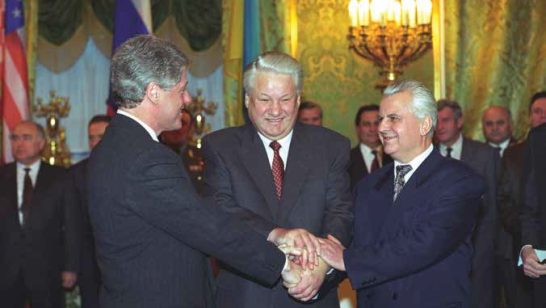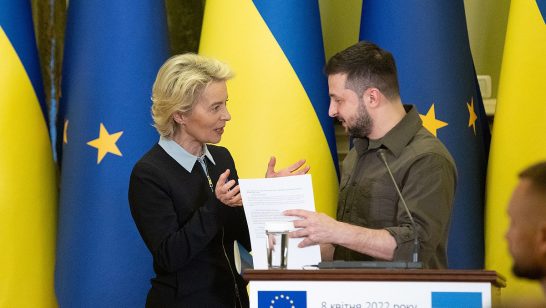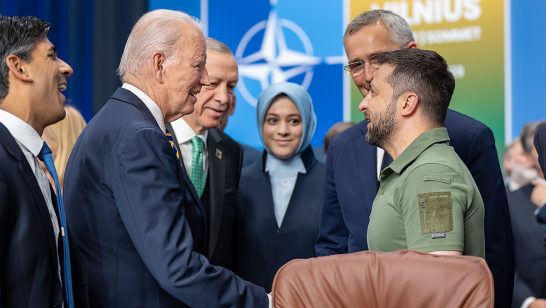
This piece is part of a series exploring security guarantees for Ukraine and the future of Euro-Atlantic security by younger-generation Ukrainian scholars and analysts.
Security guarantees assured by Ukraine’s membership in NATO remain the only fully reliable option for Ukraine post-war. However, more institutionalised and forward-looking security and defence cooperation during the war and interim period are no less critical security guarantees for Ukraine. In this sense, the G7-EU-coalition-of-willing nexus can assure a comprehensive and mutually reinforcing approach for bolstering Ukraine’s capabilities and integrating it into the Euro-Atlantic security system before the war ends. While the G7 can sustain Ukrainian military capabilities and Ukraine’s defence industry, the EU becomes a facilitating power for Ukraine’s gradual integration into the broader European security and defence architecture. Finally, the coalition of the willing might ensure an immediate deterrence against Russia and avert possible re-activation of hostilities during the interim periods of the negotiation process before Ukraine joins NATO.
Viewing NATO membership, with its collective defence and nuclear umbrella, as the most credible security guarantee in the post-hostilities settings, Ukraine needs assurances relevant for war times and the interim period. While Ukraine’s partners are demonstrating their staunch support and adapting to the new realities and demands of the ongoing war, this cooperation needs a more institutionalised and forward-looking approach. In this sense, the G7-EU-coalition-of-willing nexus can assure a comprehensive and mutually reinforcing approach for bolstering Ukraine’s capabilities and integrating it into the Euro-Atlantic security system before the war ends. This nexus will cover Ukraine’s current and future needs at the operational and industrial levels and create a solid basis for Ukraine’s future integration into the EU and NATO.
Security guarantees assured by Ukraine’s membership in NATO remain the only fully reliable option for Ukraine post-war. Kateryna Anisova
G7 framework to bolster Ukraine’s military capabilities
Currently, the most vital support for Ukraine remains weaponry and ammunition provision, intelligence sharing, and training to sustain the Armed Forces’ capabilities and means to defend the country in the ongoing war. This aspect should not be eliminated from the discussion over security guarantees for Ukraine. Partners should take a more strategic and forward-looking approach by providing relevant weapon systems in an appropriate amount supplied on time. Enhancing Ukrainian offensive capabilities is vital, as offensive weapons are decisive in the current battleground situation.
Based on the already-existing unwavering commitments, the G7, including the EU and its Member States, assures its long-term bilateral support to Ukraine in a comprehensive manner, which, in addition to the weapons provision and training, anticipates the development and reformation of Ukraine’s defence sector at industrial and organisational levels. These steps aim to strengthen Ukraine’s military and gradually lessen the state’s critical reliance on its partner’s often overdue decision-making process now and in the future.
However, to make the G7 framework more efficient, proper coordination between its parties is required. The weapons provision should make up a comprehensive picture in accordance with Ukraine’s visions of liberating its territories and deterrence of Russia. Furthermore, weapons’ sustainment and repairments should be considered when deciding which types and origins of the systems to be provided. With these commitments, Ukraine will become more integrated into the network of interlinked defence arrangements between the world’s liberal democratic powers. Therefore, decisions on bilateral cooperation with Ukraine within the G7 framework should be made anticipating their interoperability implications at the industrial level between the G7 states and Ukraine and among the G7 states. In particular, G7 states should consider Ukrainian industrial needs and offers while procuring ammunition and equipment for Ukraine and replenishing their stockpiles to ensure coherence and effectiveness.
Enhancing Ukrainian offensive capabilities is vital, as offensive weapons are decisive in the current battleground situation. Kateryna Anisova
The EU as facilitator of Ukraine’s integration into European security and defence architecture
Security guarantees for Ukraine are not only about “providing aid” but also about making Ukraine a full-fledged member of the Euro-Atlantic security community. Traditionally, the EU’s security dimension is downplayed in favour of NATO by the Eastern Flank states. However, for Ukraine, membership in the EU would be important as it would make Ukraine more intertwined with other European states in the military dimension, ultimately emphasising the importance of Ukraine for their security and stability. Indeed, this gradual integration will transform Ukraine’s actorness in regional security architecture.
Ukraine’s security integration through the EU is already happening with the European Union Military Assistance Mission Ukraine (EUMAM), the first EU mission on its soil to train Ukrainian soldiers and provide them with the necessary equipment. At the industrial level, several defence companies have already started establishing joint ventures with Ukrainian producers for battle tanks or drone manufacturing in Ukraine. Another integration dimension is the joint procurement instruments (European Defence Industry Reinforcement through Common Procurement Act (EDIRPA) and Act in Support of Ammunition Production (ASAP)). This offers a so-called “pilot project” to see if the EU can consolidate its states to foster cooperation at the defence industrial level. While this unprecedented development focuses primarily on Ukraine, the country’s participation in the talks and planning is vital for understanding industrial needs, drawbacks, and solutions to ensure European military might.
The reciprocal exchange of experience and expertise between the EU and Ukrainian militaries and defence officials in a more institutionalised framework aligns with the G7’s commitments to comprehensively support Ukraine’s defence capabilities. Permanent Structured Cooperation (PESCO) projects within the Common Security and Defence Policy (CSDP) can become an excellent opportunity for this integration, as it already anticipates the participation of third states. PESCO projects enable the interested EU Member States to jointly develop their defence capacities, mainly through the development of defence capabilities, research, acquisition, and armaments, on a voluntary basis with legally binding commitments. Moreover, Ukraine’s access to the Coordinated Annual Review on Defence (CARD) will deepen and strengthen EU-Ukraine cooperation in the defence sector. CARD is an overview of the EU defence landscape to foster coordination in the agreed and requisite areas for defence planning and capability development practices. Ukraine’s participation in those reviews will once again bolster Ukraine’s actorness in the broader European security architecture.
Security guarantees for Ukraine are not only about “providing aid” but also about making Ukraine a full-fledged member of the Euro-Atlantic security community. Kateryna Anisova
Coalition of the willing as a transition, not a substitute
Solely arming Ukraine to ensure its ability to resist a potential renewed Russian attack, a so-called “European Israel” scenario, is unacceptable for Ukraine. The only way to send Moscow a strong signal about the high costs of their renewed attack is through collective defence with a mutual defence clause, similar to the ones of Article 5 of the North Atlantic Treaty and Article 42(7) of the Treaty on European Union, between the willing states and Ukraine. Believing that clearer prospects for Ukraine’s future in NATO will appear in post-war settings, the transitional interim framework can solve Ukraine’s immediate collective defence needs and avert a renewed Russian attack right after the post-war negotiating process.
Moreover, as the experience of Finland and Sweden demonstrates, even after giving the invitation, the NATO Allies could inhibit the final accession by delaying the ratification process. This scenario for Ukraine should be considered, and, therefore, the interim multi-national security guarantees could become a solution, as was the case with the assurances provided by the UK to Finland and Sweden in May 2022.
A coalition of “like-minded” nations who are ready to agree on a mutual defence clause with Ukraine appears to be a more effective tool from a political point of view. While this coalition will not be linked to NATO and/or the EU, states that are more cautious in closer defence cooperation with Ukraine will be unable to block the decisions and/or impede decision-making. Consequently, establishing a coalition will take less time, which is crucial for Ukraine in the final stages of negotiations. This coalition can be expected to comprise Ukraine’s staunch allies, such as the UK, Poland, the Baltics, the Nordics, and potentially France.
A coalition of “like-minded” nations who are ready to agree on a mutual defence clause with Ukraine appears to be a more effective tool from a political point of view. While this coalition will not be linked to NATO and/or the EU, states that are more cautious in closer defence cooperation with Ukraine will be unable to block the decisions and/or impede decision-making. Kateryna Anisova
The coalition of the willing will not become a replacement for Ukraine’s NATO membership; however, it will deter Russia and prevent its aggressive policies in the immediate post-war setting. This agreement should be negotiated at two levels – a multilateral treaty and a legally binding bilateral agreement with Ukraine. Ensuring that this arrangement will not replace NATO, the treaty should be designed as a complementary relationship to NATO, similar to the UK-led Joint Expeditionary Force for the Northern European states. However, the JEF’s reformation and re-orientation towards anti-Russian defence becomes less relevant concerning the guarantees for Ukraine. First of all, the JEF was established by the memorandum of understanding; thus, it is not a Treaty-bound arrangement. However, as discussed earlier, it is crucial for Ukraine to have legally binding assurances. Second, the JEF is mainly based on the cooperation experience of the Northern European participating states, the level of their interoperability, and shared strategic culture. Considering the need to deter Russia in the Baltic Sea, a complete re-focus on Ukraine might not be in the interests of the JEF states. Therefore, establishing a new and separate coalition with the main commitment towards Ukraine will be more feasible.
Conclusions
Considering the ongoing dynamics of Russia’s full-scale invasion of Ukraine, the security guarantees solution should be discussed not only regarding the post-war setting but also in the current battleground situation and immediate post-hostilities environment. While fully supporting the idea that security guarantees go beyond the military domain, this commentary mainly suggests operational and industrial defence arrangements with Ukraine to ensure the country’s capabilities to resist and deter. Rather than solely granting Ukraine collective defence and strengthening its military capabilities to avert potential Russian attacks, security guarantees are ultimately about Ukraine’s comprehensive integration into the Euro-Atlantic security system and interoperability enhancement between reciprocal partners.
The opinions articulated above represent the views of the author and do not necessarily reflect the position of the European Leadership Network or all of its members. The ELN’s aim is to encourage debates that will help develop Europe’s capacity to address the pressing foreign, defence, and security policy challenges of our time.
Image credit: Wikimedia Commons / U.S. Department of State



